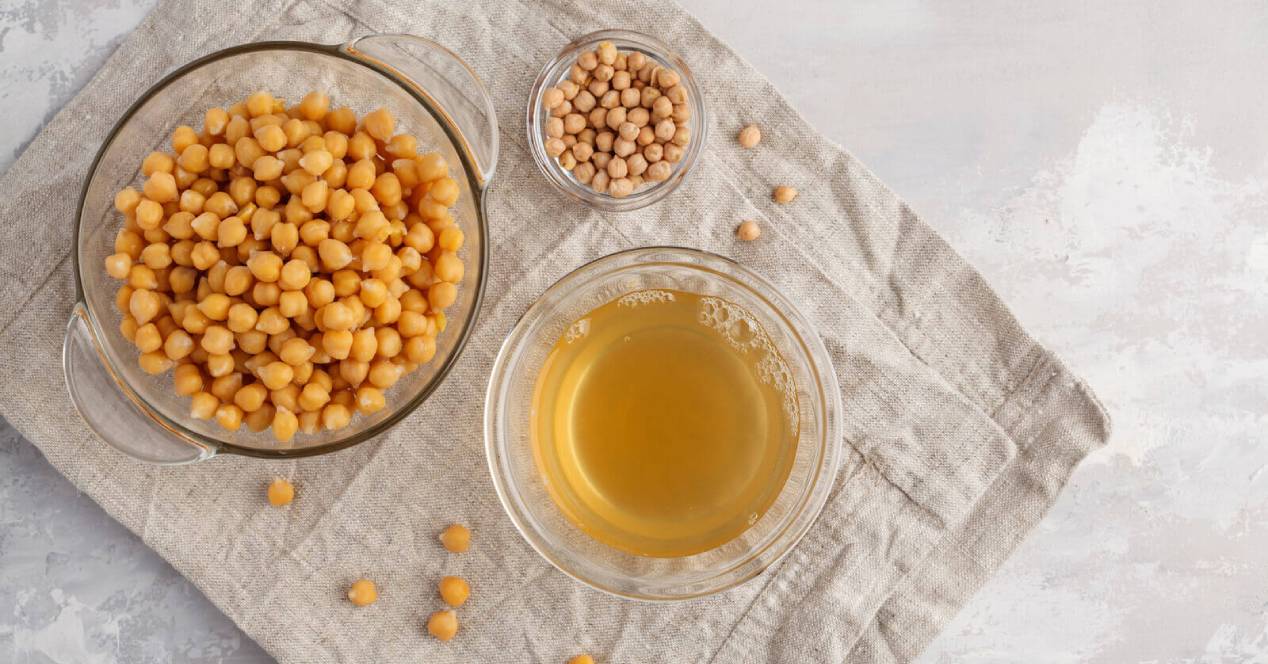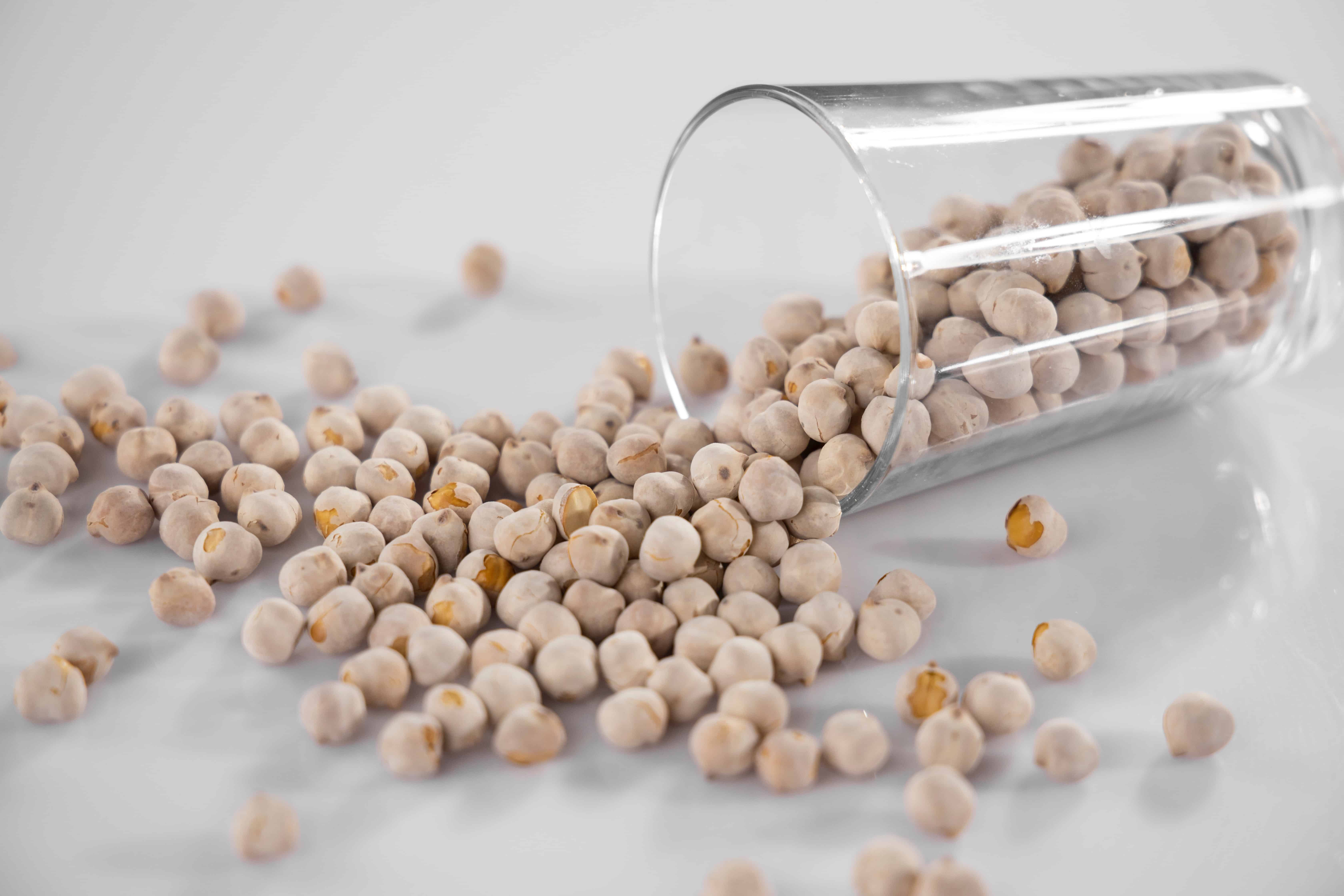
Aquafaba has become a favorite ingredient in the vegan world in recent years because it can replace egg whites in recipes.
For those who don't (or can't) eat eggs, this broth opens up a much wider range of possibilities for creating recipes and makes it possible to make those light and fluffy baked goods that many miss eating.
What is aquafaba?
This liquid is the water or brine found in canned beans. We usually rinse the beans in a colander or colander to remove the liquid, but with aquafaba we save the brine and beat it with a hand blender or stand mixer until light and fluffy. It's the liquid that some people pour out when they first open a can of chickpeas, for example.
This substance was named by combining the Latin words for water and legume: aqua and faba. Legumes are edible seeds that come from the legume family of plants. They contain a relatively high amount of carbohydrates, mainly starch. Starch is the energy storage form found in plants and is made up of two polysaccharides called amylose and amylopectin.
When legumes are cooked, the starches absorb water, swell and eventually break down, causing amylose and amylopectin, along with some proteins and sugars, to leach into the water. This results in the viscous liquid known as aquafaba.
Although this liquid has been around for as long as legumes have been cooked, it didn't get much attention until 2014, when a French chef discovered that it could be used as an ingredient in recipes. He realized that he was an excellent substitute for egg whites and that it could also be used as an agent sparkling.
This finding spread rapidly among food enthusiasts, and before long chefs all over the world were using aquafaba. Plus, it was particularly popular with vegans because aquafaba makes a great vegan-friendly egg substitute.
When first opened, chickpea water may smell like beans. However, after mixing it with the recipe, that smell and taste softens, leaving a more neutral taste. If we use a different type of legumes, or if the chickpeas are salted, the results may be different.
Uses in the kitchen
While research on the nutritional composition and potential health benefits of aquafaba is limited, it has been shown to have many culinary uses.
Egg White Replacement
It is known to be an amazing substitute for eggs. Although the exact science behind why aquafaba works so well as an egg replacement is unknown, it may have to do with its combination of starches and small amounts of protein. It is most commonly used as a replacement for egg whites, but can also be used as a substitute for whole eggs and egg yolks. In addition, it is suitable for vegans and suitable for people who are allergic or intolerant to eggs.
This syrupy liquid has been celebrated by vegan bakers for its incredible ability to mimic the action of eggs in recipes, providing structure and height to baked goods like cakes and brownies. It can even be whipped into a fluffy meringue like egg whites or into delicious, vegan and allergy-friendly desserts like mousse and macaroni.
Aquafaba is also a popular ingredient in savory vegan versions of traditionally egg-based recipes like mayonnaise and aioli. Even baristas use it to create vegan and egg allergy-friendly versions of cocktails that are traditionally made with egg whites.
Experts suggest substituting 3 tablespoons (45 ml) of aquafaba for one whole egg or 2 tablespoons (30 ml) for one egg white.
Vegan Dairy Replacement
In addition to being a stellar egg substitute, aquafaba is a dairy substitute. Vegans or people with lactose intolerance often look for dairy-free options to add to their recipes. It can be used in place of milk or butter in many recipes without affecting the texture or flavor of the food.
For example, we can make a delicious dairy-free butter by combining aquafaba with apple cider vinegar, coconut oil, olive oil, and salt. It can be whipped into a delicious whipped cream that is sometimes used by baristas to add the signature foam to cappuccinos and lattes.
Other uses
You can also use this liquid in a variety of sweet or savory recipes, such as:
- Meringue: We will beat aquafaba with sugar and vanilla to form an eggless meringue. We can use this to cover cakes or make cookies.
- Foam As an Egg Replacer: We'll whip it into a foam and use it as an egg replacer in recipes like muffins and cakes.
- Egg Replacement: We will substitute beaten aquafaba for eggs in pizza dough and bread recipes.
- Mayonnaise vegan: we will mix aquafaba with apple cider vinegar, salt, lemon juice, mustard powder and olive oil to obtain a dairy-free vegan mayonnaise.
- Butter vegan: We will mix aquafaba with coconut oil, olive oil, apple cider vinegar and salt to create a vegan and dairy-free butter.
- Macaroni: We'll replace the egg whites with whipped aquafaba to make eggless coconut macaroni.
Because aquafaba is such a recent find, new ways to use this exciting ingredient are being discovered every day. We must store aquafaba in the same way that we would store raw egg whites. That is, it must remain fresh in the fridge for two or three days.

Nutritional properties
Since aquafaba is a relatively new trend, there is limited information on its nutritional composition. It is estimated that in one tablespoon (15 ml) we find 3 to 5 calories, of which less than 1% comes from protein. It may also contain small amounts of certain minerals like calcium and iron, but not enough to be considered a good source.
Although there is currently no reliable nutritional information on aquafaba, more details on the positive health effects may become available in the future as it becomes more popular.
Services
There is not much research on this liquid yet, but there is still a great opportunity to explore the health benefits it can offer. Despite the little-developed data so far, vegans and advocates of legumes claim that they have the following benefits:
Suitable for vegans
Being produced solely from chickpeas or another legume, aquafaba is a plant ingredient and is valuable to those who follow a vegan lifestyle. And with the versatility it offers in the kitchen, including acting as a vegan egg substitute, it offers opportunities for vegetable lovers to enjoy numerous recipes.
Low in calories
With such minimal nutritional content, the use of aquafaba makes it beneficial for people who watch the calories in their diet. Although it is itself low in calories, it is important to pay attention to the added ingredients that contribute to the total caloric volume.
For example, a tablespoon of real mayonnaise provides about 90 calories and 10 grams of fat, while vegan aquafaba-based mayonnaise is nutritionally equivalent and is formulated with sunflower oil. Regardless of the source chosen, people need to keep portion sizes and portions in mind.
dairy free
It can mimic the consistency of eggs and dairy, making it extremely valuable to use for those who choose or need to avoid it. As we said above for people who follow a vegan lifestyle, aquafaba can transform previously "forbidden" foods into "safe" products, ultimately allowing people to expand their repertoire of recipes. In addition it is considered gluten free.
Disadvantages of its habitual use
There are some tips that we must take into account to avoid disadvantages in the consumption of aquafaba.
BPA
Many canned goods contain bisphenol A (BPA), a chemical that interferes with our hormones. It is also found in plastics and baby items.
BPA is linked to infertility, hormone-related cancers, and hyperactivity in children. In canned goods, BPA leaches from the lining into the food and also into the liquid surrounding that food.
Anti-nutrients and compounds that influence digestion
Beans contain various anti-nutrients and other compounds that can negatively affect us.
- Acid phytic: binds to vitamins and minerals, making them less available for us to use.
- Oligosaccharides: They are sugars that remain undigested until they reach the colon, where the feast of bacteria begins, which usually produce gas.
- Saponins: they have a bitter, soapy quality that helps the aquafaba stir and foam. Although saponins have some positive benefits, they can be very difficult to digest, leading to digestive upset (especially for those with existing digestive issues) and can even lead to leaky gut.
This is not to discourage anyone from eating legumes, as they are loaded with essential nutrients like protein, fiber and iron. The process of cooking them helps reduce some of these compounds, and where do they go? They are released into the water (aquafaba).
produces gases
Many of us have some undesirable digestive effects after eating beans. There are many ways we can safely reduce our gassy response to beans, but one of the worst culprits is oligosaccharides, that leach into the cooking water. When we use aquafaba, we use the part that is likely to make us gassiest.
High sodium content
Canned and processed foods contain large amounts of salt as a preservative. Rinsing the beans allows you to send some of this salt down the drain. One study also found that canned brine containing sodium EDTA y disodium affects the volume and stability of the aquafaba foam. If you are going to use aquafaba, opt for the unsalted beans, as this will allow for a lighter, fluffier aquafaba.
It has no nutritional value
Although aquafaba is an excellent egg substitute for those with dietary restrictions and food allergies, it is not a good source of nutrients and cannot compete with the nutritional content of eggs or dairy.
Let's remember that it is extremely low in calories, protein, carbohydrates, and fat, and contains few, if any, vitamins or minerals. On the other hand, eggs and dairy are nutritional powerhouses. One large egg provides 77 calories, 6 grams of protein, and 5 grams of healthy fat. Plus, eggs contain almost all the nutrients you need, as well as powerful antioxidants.
Although aquafaba is a convenient replacement for eggs or dairy, especially for those who are allergic or don't eat these foods, it's important to note that it contains significantly fewer nutrients. By replacing eggs or dairy with aquafaba, you will lose all the nutritional benefits they offer.
aquafaba recipe
Aquafaba can be the water you used to boil the bagged legumes (lentils, beans, and chickpeas), or it can be the liquid from the canned versions of these foods. It seems to work best when derived from beans or chickpeas. With a bit of whipping, the liquid develops a fluffy texture that resembles whipped egg whites, whipped cream, or milk foam.
It is recommended to drain the can of chickpeas into a mixing bowl. If it looks thinner than egg whites, we can reduce it to a thicker texture in the pot. We will simmer the liquid over medium-low heat until it is closer to the consistency of egg whites. Let it cool completely before using it. Chickpea water does not need to be refrigerated before using.